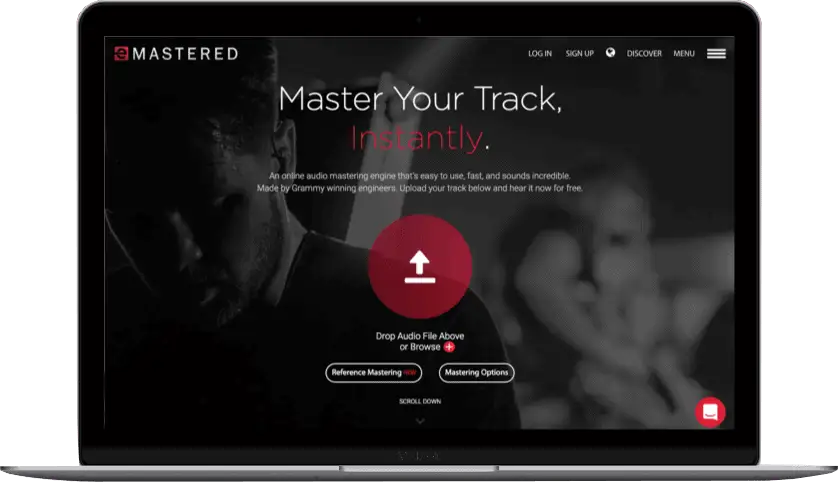Breaks have been part of the musical conversation since the ‘80s, cracked open on vinyl, chopped into bits, and repurposed into everything from golden-era hip-hop to jungle, big beat, and beyond. And while they never really disappeared, breakbeats are having a serious moment right now , sliding back into electronic music, sample-heavy pop, and underground club scenes across the map.
The wild part is that even with all the buzz around breakbeat this and breakcore that, there’s still a ton of confusion out there, especially among newer producers. What is a breakbeat, really? Is it a genre? A drum loop? A vibe? (Spoiler: it’s kind of all three.)
Whether you're just diving in or you’ve been dragging drum loops across the grid for years, this article will walk you through everything you need to know about how to make a proper breakbeat, from what makes a break a break, to chopping, sequencing, and processing your own.
What Is a Breakbeat?
At its core, a breakbeat is a drum groove that’s been lifted or “sampled” from an existing track, usually a funk, soul, or jazz record. What makes it a break is that it’s often pulled from the drum-only section of a song. The isolated bars of drums are where we find the magic.
Most classic breakbeats are looped and chopped into new rhythmic patterns , forming the backbone of entire genres like hip-hop, jungle, and breakbeat hardcore.
Some of the most iconic breakbeats in history trace their roots back to a handful of records:
- "Amen Brother" – The Winstons (the Amen break)
- "Funky Drummer" – James Brown
- "Apache" – The Incredible Bongo Band
- "Think (About It)" – Lyn Collins
Producers in the ‘80s started hunting these kinds of breaks down on dusty vinyl, often finding their treasure in dollar-bin 45s, forgotten B-sides, or crate-dug LPs from the ‘60s and ‘70s. The more obscure, the better.
Check out our " Greatest Drum Breaks of All Time " article for a deeper look into famous breaks.
The Rise of Sampling
As technology caught up, these breakbeats became easier to grab. Early hip-hop producers were using gear like the E-mu SP-1200, Akai MPC60, and Ensoniq ASR-10 to slice drum breaks into pieces and rearrange them like rhythmic Legos. It was a gritty, hands-on process that required time, patience, and a deep record collection.
Artists like Public Enemy, Eric B. & Rakim, and N.W.A. were building tracks around these chopped-up drum breaks, giving them new context and energy. Meanwhile, producers in the UK would soon take those same loops and speed them up to launch the rave explosion.
These samples primarily came from old funk and soul records.
Today, breakbeats are everywhere. You can hear them in lo-fi house tracks, halftime DnB, and even pop music. But it all started with a few bars of drums, a sampler, and someone crazy enough to reimagine the beat.
If you want to make breakbeat music of any kind, the first step is knowing how to put one together.
How to Make a Breakbeat in 7 Steps
The great thing about making breakbeats today is that you don't need to have access to hardware drum machines or even have deep knowledge of drum programming. All you really need is your DAW of choice and a solid break sample to get started.
Let me break it down into seven easy steps for you.
Step 1: Find Your Breakbeat Sample
Before you do anything, you need a solid source.
Whether you're digging through vinyl, cruising Splice, or pulling a forgotten gem from your sample folder, the right break sets the vibe. For this example, I grabbed a dusty soul drum loop with a raw snare and just enough swing. You want something with character. It shouldn't be too clean or too quantized. Think James Brown’s “Funky Drummer” or The Winstons’ “Amen Brother.”
Here's the raw, unedited breakbeat loop loaded into Ableton Live.
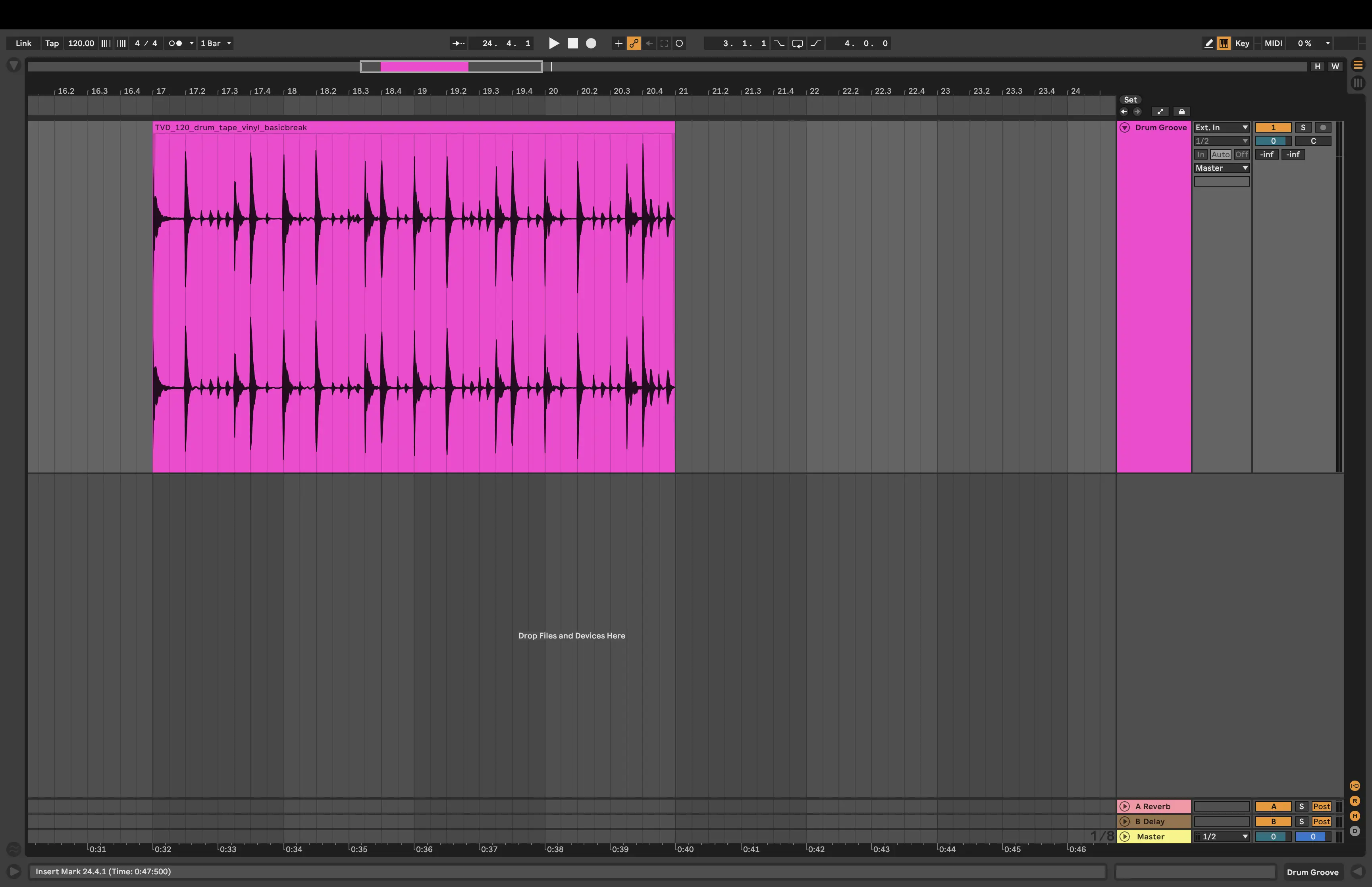
Step 2: Warp and Time-Stretch the Break
Once you’ve dragged your break into Ableton, head straight to Warp mode.
This will make sure your loop plays nice with the project’s BPM. I usually go with “Complex” or “Beats” warp mode, depending on how the break sounds. Zoom in and make sure your downbeats are lining up. It should groove without stretching weird.
Here's the warped version of the break:
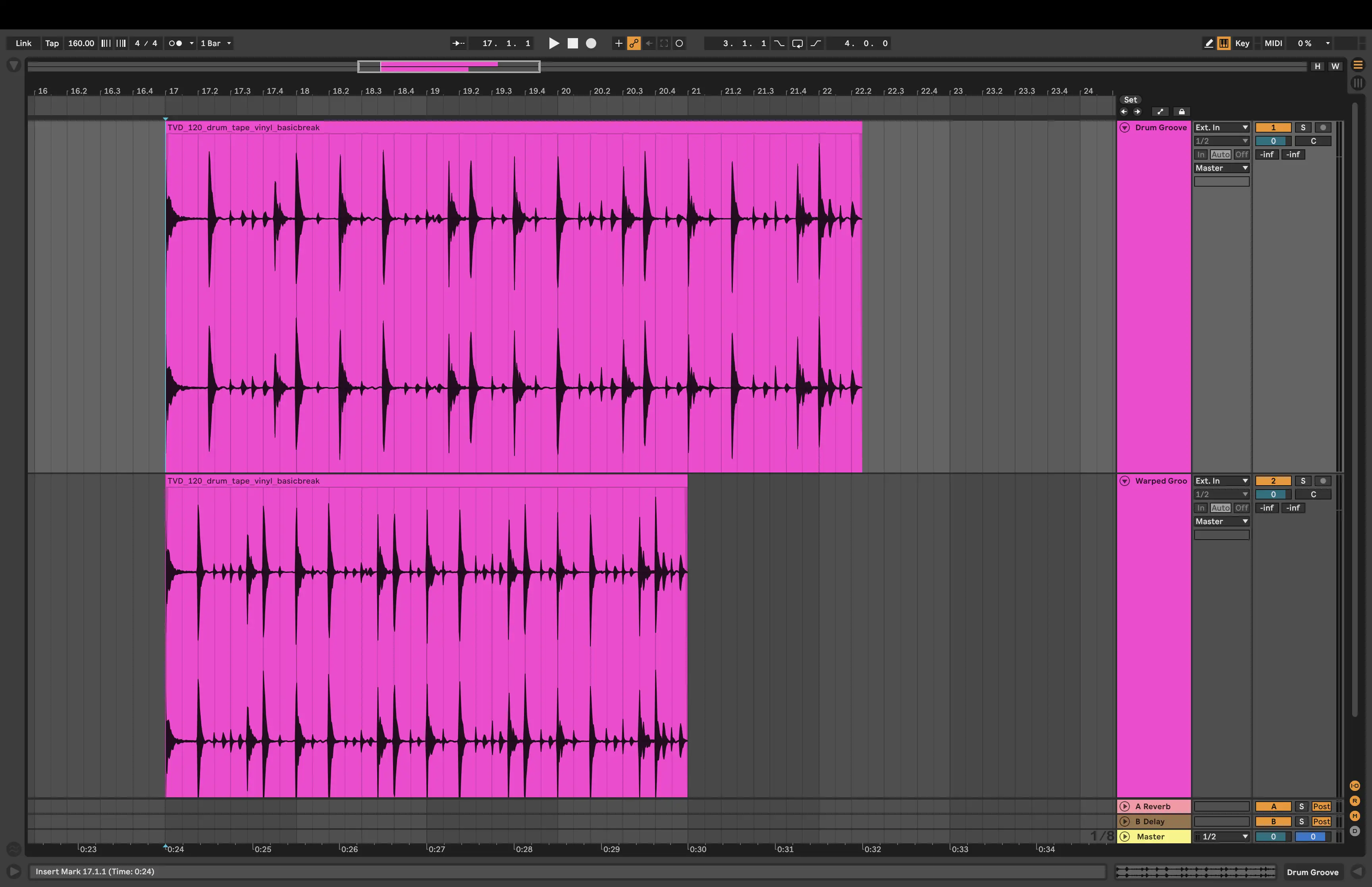
Step 3: Slice the Break to a Drum Rack
Now it’s time to slice and dice. Right-click the clip and choose “Slice to New MIDI Track.” I usually slice at transients or quarter notes for more flexibility. This gives you each drum hit on a separate pad, ready for reassembly.
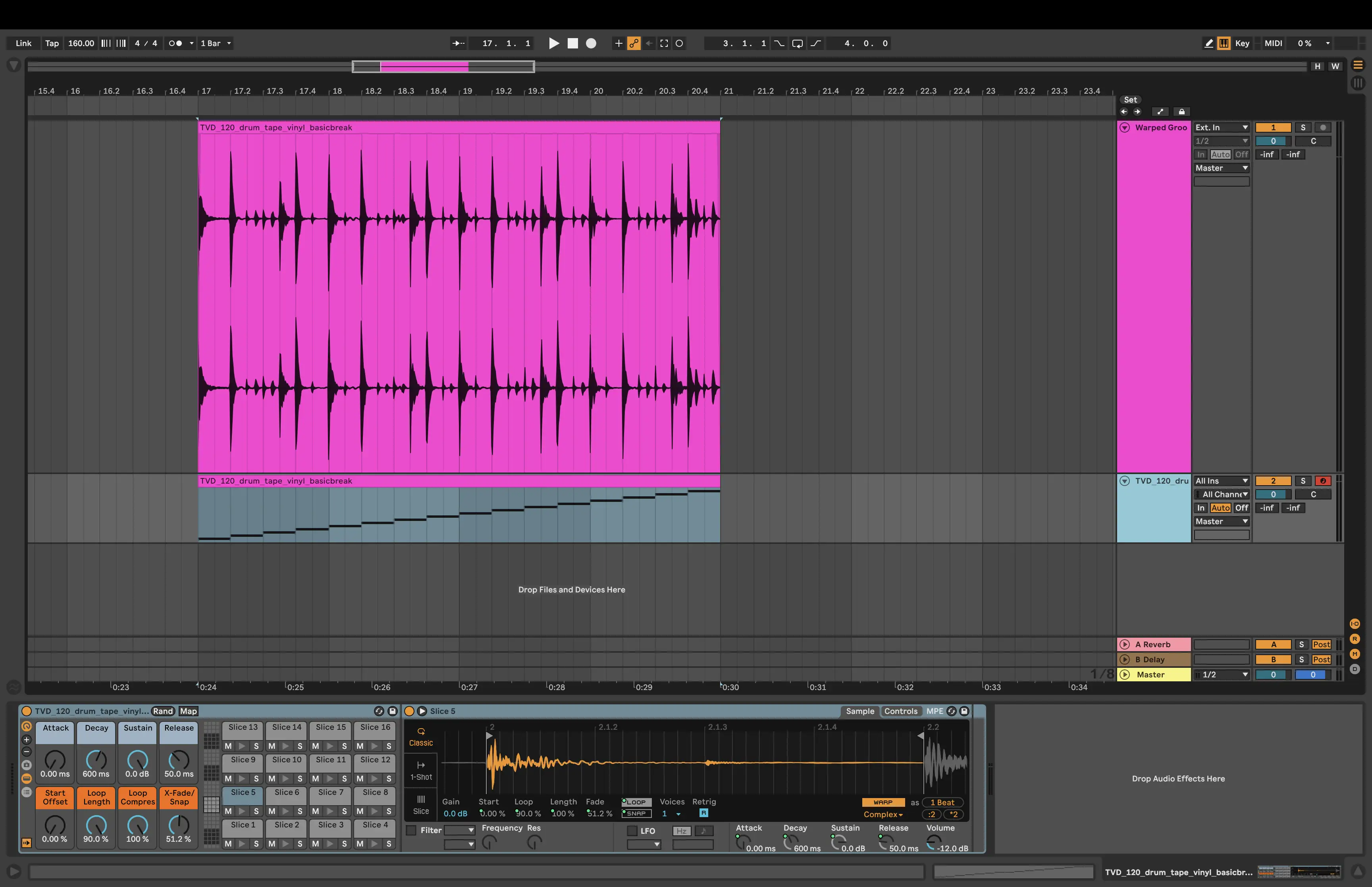
Step 4: Rearrange the Slices
Now, use your MIDI piano roll to lay down a new beat with those chopped pieces. Try moving the snare to unexpected spots, layering ghost notes, or repeating hi-hat hits for swing.
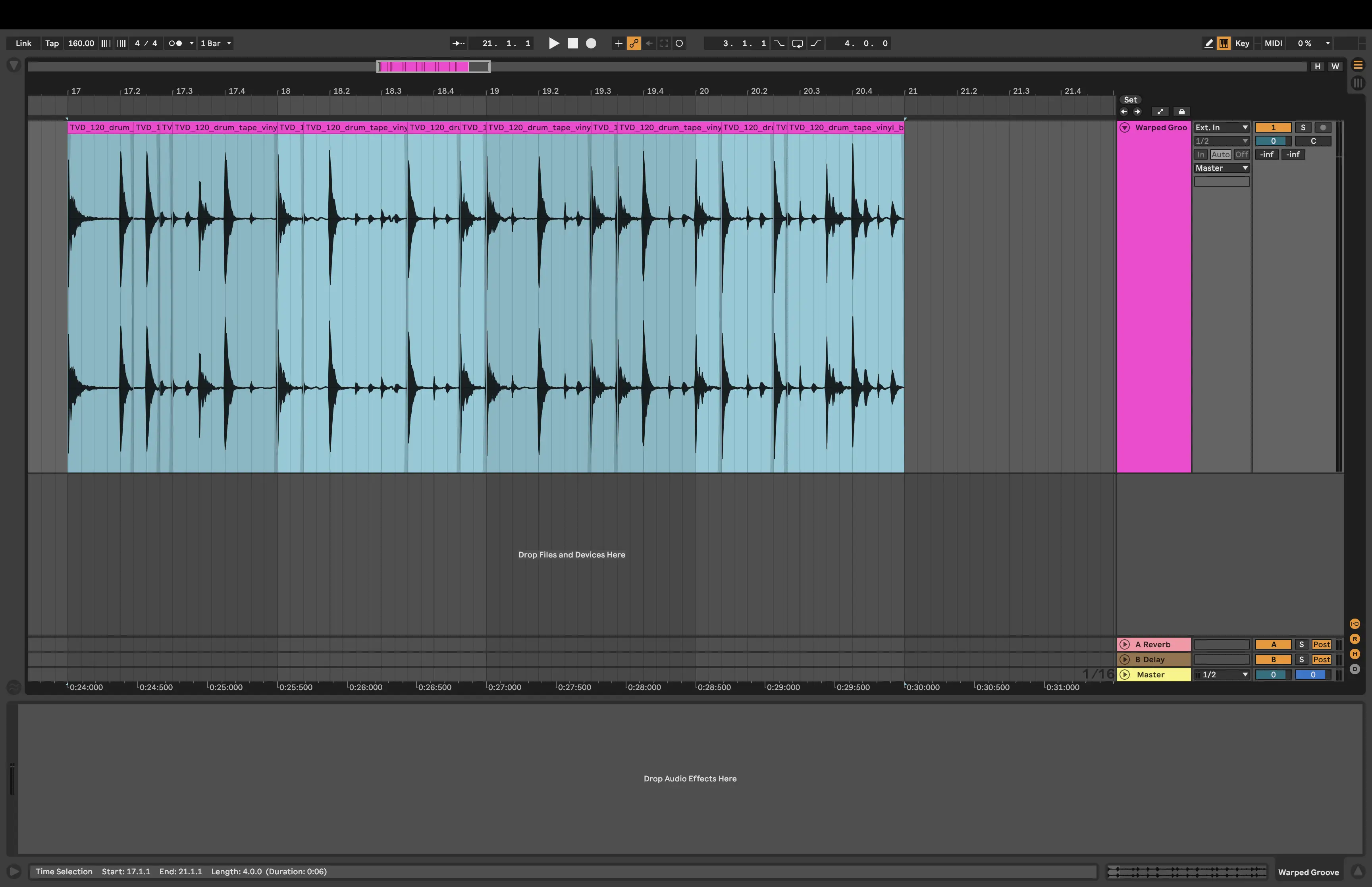
Step 6: Layer Additional Drums
If you want to make your breakbeat sound even more unique, I recommend adding some other drums layers and loops on top.
For this particular loop, I wanted a deep, resonant kick with more sustain, a wider snare with some room reverb, a filtered ride cymbal, and a tambourine. The additional ride and tambourine were sidechained to the kick and snare to glue everything together and give those the chance to shine through.
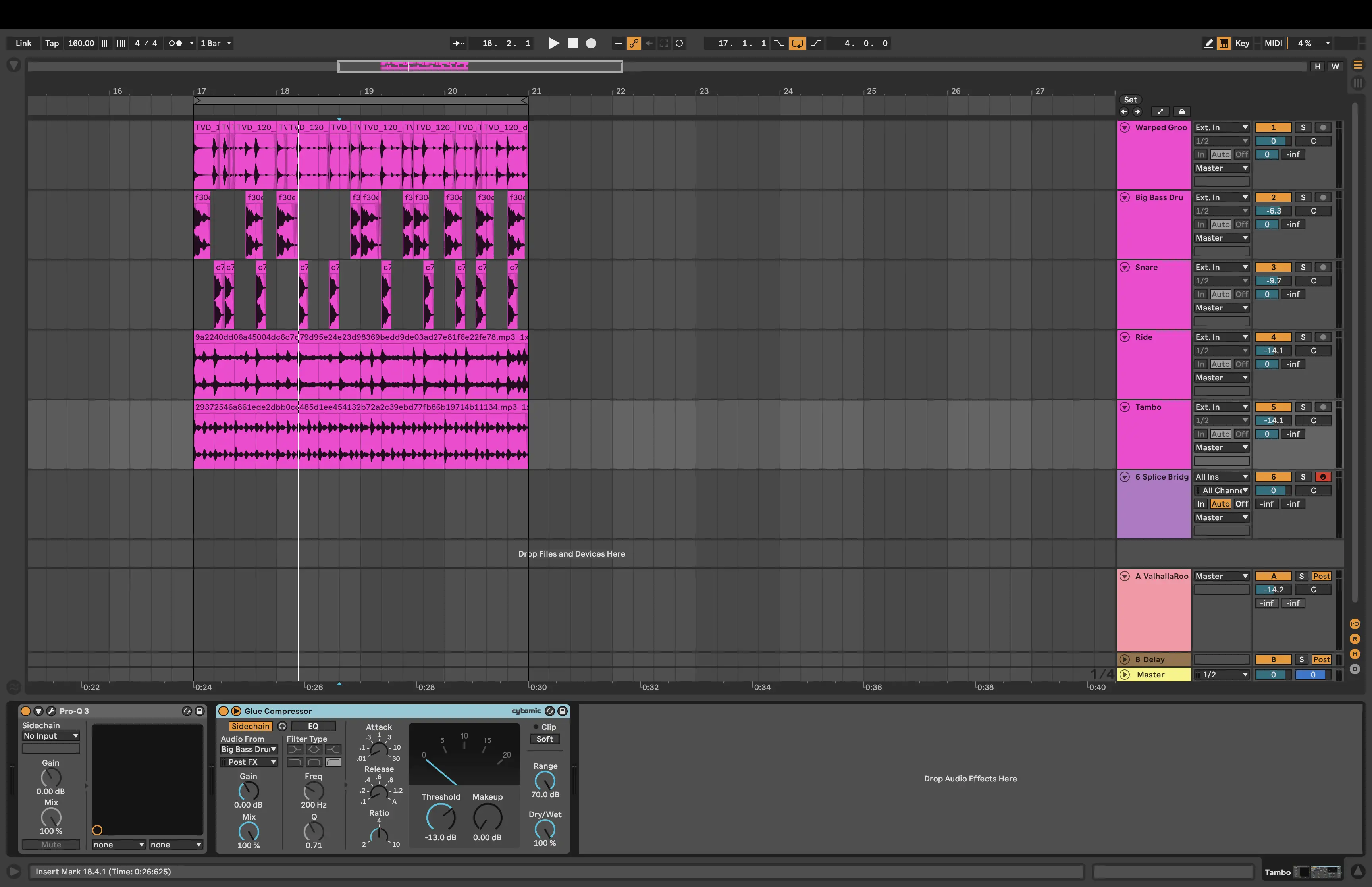
Step 7: Process the Break
Classic breaks tend to have a tight feel, and at this point, my break was beginning to feel a bit floppy. To clean things up, I bussed all of my loops to a single auxiliary track to process them together. The goal here was to "glue" them and get them to act as a cohesive unit.
I started with a transient shaper on the bus, which accentuated the attack and dialed back the sustain of the drums overall. From there, I used a bit of multiband compression in parallel, squeezing each of the bands pretty hard and mixing them in under the raw signal.
I then cut out a resonant frequency I didn't like around 800 Hz and boosted the ultra lows and highs with EQ shelves.
And because life is brighter with a little saturation, I added Soundtoys Decapitator last in the chain for a bit of parallel distortion.
Here's what the breakbeat sounds like with a bit of drum processing:
What Comes After the Break?
Once you have your breakbeat loop hitting just like you like it, you might be thinking, now what?
Well, while this piece was meant to focus solely on making your own breakbeats, it would be cruel to leave without discussing the aftermath.
Breakbeats are just the rhythmic foundation in most styles of music production. To turn that beat into a full track, you need to start thinking like a producer.
While there are infinite ways to produce a track, I typically like to start with bass.
Breakbeat music (especially in styles like jungle or UK hardcore) often leans into deep, sub-heavy basslines. Whether you're programming a Reese bass on a synth, sampling a gnarly low-end loop, or recording something live, your bass should lock in rhythmically with your kick and leave space for everything else.
From there, I'll often look into melodic elements. This can be anything from chopped vocal hits to stabs or pads to jazzy Rhodes chords that have been manipulated and mangled with multi-fx plugins. A lot of classic breakbeat tracks borrow samples from funk, soul, or dub records. Just make sure whatever you’re adding complements the energy of your beat, not everything needs to be musical. Sometimes a reversed texture or one-hit FX burst is all you need to bring a section to life.
From there, you can start to structure your track so that there are dynamics from one section to the next. Even if you’re only working with a few elements, creative arrangement is key. Think about how you can build tension. Maybe drop out the drums for a bar or two, filter the bass, or automate a riser before dropping everything back in. Listen to standout producers in this style of music production, and you'll notice how they use variation to keep listeners engaged.
As the cherry on top, I often like to sprinkle in some ambience here and there. This could include a bit of reverb or delay to give certain elements space and depth, or background vinyl crackle to glue the track together.
In conclusion, the point is that once your breakbeat’s bouncing, the possibilities open wide. Experiment, trust your ears, and don’t be afraid to get weird - that’s where the best breakbeat tracks are born.




